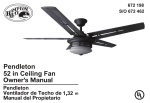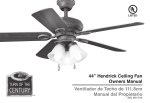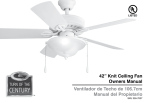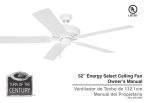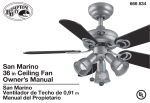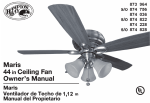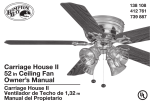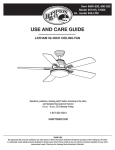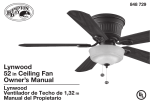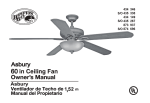Download Hampton Bay 13087 Instructions / Assembly
Transcript
454 849 s/o 455 805 s/o Tropics 54 Tropics 7 54” Tropics Ceiling Fan by Hampton Bay (2) 60 Watt Intermediate Base Bulbs Included Tuscan Amber Glass 3-Speed Reverse Function for Year-Round Comfort and Savings Full Function Remote Control Included Thank you for purchasing this Hampton Bay ceiling fan. This product has been manufactured with the highest standards of safety and quality. The finish of this fan is weather resistant, but over time will naturally weather and fade. Table of Contents Safety Rules....................................... 1 Unpacking Your Fan......................... 2 Installing Your Fan........................... 3 Operating Your Fan.......................... 9 Operating Your Remote Control..... 10 Care of Your Fan............................... 11 Troubleshooting................................. 11 QUESTIONS, PROBLEMS, MISSING PARTS: Before returning to your local Home Depot, please call our Customer Service Team at 1-877-527-0313 or visit www.homedepot.com. Specifications..................................... 12 Warranty Information...................... 13 Please reference your SKU (454 849 weathered cane) or UPC (082392 390877 weathered cane). UL Model No. 54-TS READ AND SAVE THESE INSTRUCTIONS 1. To reduce the risk of electric shock, insure electricity 2. 3. 4. 5. 6. 7. has been turned off at the circuit breaker or fuse box before beginning. All wiring must be in accordance with the National Electrical Code ANSI/NFPA 70-1999 and local electrical codes. Electrical installation should be performed by a qualified licensed electrician. WARNING: To reduce the risk of fire or electric shock, this fan should only be used with fan speed control part no. UC7067RC, manufactured by Rhine Electronic Co., Ltd. CAUTION: To reduce the risk of personal injury, use only the screws provided with the outlet box. The outlet box and support structure must be securely mounted and capable of reliably supporting a minimum of 35 pounds. Use only UL Listed outlet boxes marked “FOR FAN SUPPORT.” The fan must be mounted with a minimum of 7 feet clearance from the trailing edge of the blades to the floor. Avoid placing objects in path of the blades. TO REDUCE THE RISK OF FIRE, ELECTRIC SHOCK OR PERSONAL INJURY, MOUNT FAN TO OUTLET BOX MARKED “ACCEPTABLE FOR FAN SUPPORT OF 35LBS (15.9KG) OR LESS” AND USE MOUNTING SCREWS PROVIDED WITH THE OUTLET BOX. MOST OUTLET BOXES COMMONLY USED FOR THE SUPPORT OF LIGHTING FIXTURES ARE NOT ACCEPTABLE FOR FAN SUPPORT AND MAY NEED TO BE REPLACED. CONSULT A QUALIFIED ELECTRICIAN IF IN DOUBT. 8. To avoid personal injury or damage to the fan and other items, be cautious when working around or cleaning the fan. 9. Do not use water or detergents when cleaning the fan or fan blades. A dry dust cloth or lightly dampened cloth will be suitable for most cleaning. 10. After making electrical connections, spliced conductors should be turned upward and pushed carefully up into outlet box. The wires should be spread apart with the grounded conductor and the equipment-grounding conductor on one side of the outlet box. 11. Electrical diagrams are for reference only. Light kits that are not packed with the fan must be UL Listed and marked suitable for use with the model fan you are installing. Switches must be UL General Use Switches. Refer to the instructions packaged with the light kits and switches for proper assembly. 12. All set screws must be checked and retightened where necessary before installation. TO REDUCE THE RISK OF PERSONAL INJURY, DO NOT BEND THE BLADE BRACKETS (ALSO REFERRED TO AS “FLANGES”) DURING ASSEMBLY OR AFTER INSTALLATION. DO NOT INSERT OBJECTS IN THE PATH OF THE BLADES. TO REDUCE THE RISK OF SHOCK, THIS FAN MUST BE INSTALLED WITH AN ISOLATION WALL CONTROL/SWITCH. Safety Rules 1. Unpack your fan and check the contents. You should have the following items: 1. 2. 3. 4. 5. 6. 7. Slide-On Mounting Plate (inside Canopy) Downrod and Ball Assembly Fan Motor Assembly Canopy Decorative Downrod Frame Decorative Motor Collar Cover Blades (5) 8. Glass Bottom Cover 9. Blade Bracket with Captive Screws (5) 10.Blade Bracket Support Plates (5) 11.Finial and Threaded Tube 12.Bulbs (2) 13.Hand Unit/Receiver 14.Glass Shade IMPORTANT: THIS PRODUCT AND/OR COMPONENTS ARE COVERED BY ONE OR MORE OF THE FOLLOWING U.S. PATENTS: 5,947,436; 5,988,580; 5,971,573; 6,010,110; 6,010,306; 6,039,541; 6,046,416 AND OTHER PATENTS PENDING. 2. Unpacking Your Fan a. b. c. d. Blade attachment hardware (15 screws and lockwashers) Mounting & Electrical Hardware (1 bolt, 1 clevis pin, 3 plastic wire connectors) Blade Balancing Kit Extra Blade Bracket Attachment Hardware (1 screw and lockwasher) PLEASE REMOVE FOAM PIECES AND CARDBOARDS ON THE BOTTOM OF THE FAN BEFORE INSTALLING BLADES OR TESTING MOTOR. Tools Required Phillips screw driver, straight slot screw driver, adjustable wrench, step ladder, and wire cutters. Figures 1 and 2 are examples of different ways to mount the outlet box. Outlet Box Mounting Options To hang your fan where there is an existing fixture but no ceiling joist, you may need an installation hanger bar as shown in Figure 3 (available at your Hampton Bay retailer). If there isn’t an existing outlet box, then read the following instructions. Disconnect the power by removing fuses or turning off circuit breakers. Secure the outlet box directly to the building structure. Use appropriate fasteners and building materials. The outlet box and its support must be able to fully support the moving weight of the fan (at least 35 lbs.) Do not use plastic outlet boxes. TO REDUCE THE RISK OF FIRE, ELECTRIC SHOCK OR PERSONAL INJURY, MOUNT FAN ONLY TO AN OUTLET BOX MARKED ACCEPTABLE FOR FAN SUPPORT AND USE THE MOUNTING SCREWS PROVIDED WITH THE OUTLET BOX. OUTLET BOXES COMMONLY USED FOR THE SUPPORT OF LIGHTING FIXTURES MAY NOT BE ACCEPTABLE FOR FAN SUPPORT AND MAY NEED TO BE REPLACED. CONSULT A QUALIFIED ELECTRICIAN IF IN DOUBT. Figure 3 Figure 1 WHEN INSTALLING ON A STEEP SLOPED CEILING, THE MAXIMUM ANGLE ALLOWABLE IS APPROXIMATELY 15 DEGREES. Outlet Box Figure 2 Installing Your Fan 3. Hanging the Fan REMEMBER to turn off the power. Follow the steps below to hang your fan properly. NOTE: This fan is recommended for the standard ceiling mounting using the downrod provided with this fan. When using standard ceiling installation, the distance from the ceiling to the bottom of the light kit will be approximately 28 inches. THE FAN MUST BE MOUNTED WITH A MINIMUM OF 7 FEET CLEARANCE FROM THE TRAILING EDGE OF THE BLADES TO THE FLOOR. IF YOU FEEL THAT YOU DO NOT HAVE ENOUGH ELECTRICAL WIRING KNOWLEDGE OR EXPERIENCE, HAVE YOUR FAN INSTALLED BY A LICENSED ELECTRICIAN. Standard Ceiling Mounting 1. Remove the mounting plate from the canopy by loosening the four screws on the top of the canopy (Figure 4). 2. Route the wires exiting the top of the fan motor through the decorative motor collar cover and decorative downrod frame. Route the wires through the canopy and then through the ball/downrod assembly (Figure 5). 4. UL Listed Outlet Box Remove Mounting Screws (supplied with outlet box) Hook Slide Mounting Bracket Over Screw Heads Figure 4 3. Loosen, but do not remove, the set screws on the collar on the top of the motor housing. 4. Align the holes at the bottom of the downrod with holes in the collar on top of the motor housing (Figure 5). Carefully insert the bolt through the holes in the collar and downrod. Be careful not to jam the pin against the wiring inside the downrod. Insert the clevis pin through the hole near the end of the bolt until it snaps into its locked position as noted in the circle inset of Figure 5. FAILURE TO PROPERLY INSTALL THE LOCKING PIN AS NOTED IN STEP 4 COULD RESULT IN FAN LOOSENING AND POSSIBLY FALLING. 5. Retighten the set screws on the collar on top of the motor housing. 6. Make sure the decorative downrod frame and motor collar cover properly seat on the top of the fan motor assembly. 120V Wires Ceiling Mounting Plate Motor Wires Ball/Downrod Canopy Decorative Motor Collar Cover Pin in locked Position Decorative Downrod Frame Bolt Tighten Screws Clevis Pin Motor Collar Figure 5 7. Proceed to “Installing the Fan” section. Installing Fan to the Outlet Box 1. Pass the 120-volt supply wires through the center hole in the ceiling mounting plate as shown in Figure 5. 2. Install the ceiling mounting plate on the outlet box by sliding the mounting plate over the two screws provided with the outlet box (Figure 5). If necessary, use leveling washers (not included) between the mounting plate and the outlet box. Note that the flat side of the mounting plate is toward the outlet box (Figure 5). 3. Securely tighten the two mounting screws. 4. Carefully lift the assembly up to the ceiling mounting plate. Make sure the tab on the mounting plate socket is properly seated in the groove in the hanger ball. Making the Electrical Connections REMEMBER to disconnect the power. If you feel you do not have enough electrical wiring knowledge or experience, have your fan installed by a licensed electrician. Follow the steps below to connect the fan to your household wiring. Use the wire connecting nuts supplied with your fan. Secure the connectors with electrical tape. Make sure there are no loose strands or connections (Figure 6). 1. Insert the receiver into the ceiling mounting plate with the flat side of the receiver facing the ceiling. 2. Connect both green wires from the downrod and mounting plate to the bare copper (Ground) from the outlet box 3. Connect the black wire (AC IN L) from the receiver unit to the black wire from the outlet box. 4. Connect the white wire (AC IN N) from the receiver unit to the white wire from the outlet box. 5. Connect the white wire (To Motor N) from the receiver unit to the white wire from the fan assembly. 6. Connect the black wire (To Motor L) from the receiver unit to the black wire from the fan assembly. 7. Connect the blue wire (For Light) from the receiver unit to the blue wire from the fan. After wires are connected, carefully tuck them into the outlet box. Insert the receiver unit into the mounting plate; make sure the black antenna wire sits on top of the receiver unit. THE FREQUENCIES ON YOUR RECEIVER AND TRANSMITTER HAVE BEEN PRESET AT THE FACTORY. BEFORE INSTALLING THE RECEIVER, MAKE SURE THE DIP SWITCHES ON THE RECEIVER AND TRANSMITTER ARE SET TO THE SAME FREQUENCY. THE DIP SWITCHES ON THE TRANSMITTER ARE LOCATED INSIDE THE BATTERY COMPARTMENT. EACH WIRE NUT (WIRE CONNECTOR) SUPPLIED WITH THIS FAN IS DESIGNED TO ACCEPT UP TO ONE 12 GAUGE HOUSE WIRE AND TWO WIRES FROM THE FAN. IF YOU HAVE LARGER THAN 12 GAUGE HOUSE WIRING OR MORE THAN ONE HOUSE WIRE TO CONNECT TO THE FAN WIRING, CONSULT AN ELECTRICIAN FOR THE PROPER SIZE WIRE NUTS TO USE. 5. Finishing the Fan Installation WHEN USING THE STANDARD BALL/DOWNROD MOUNTING, THE TAB IN THE RING AT THE BOTTOM OF THE MOUNTING PLATE MUST REST IN THE GROOVE OF THE HANGER BALL. FAILURE TO PROPERLY SEAT THE TAB IN THE GROOVE COULD CAUSE DAMAGE TO WIRING. Screws and Lockwashers Blade Bracket Support Plate Blade Figure 7 1. Align the four screw holes in the canopy with the four screw holes in the mounting plate. 2. Secure the canopy in place by using the four mounting screws that were removed in step 1, described on page 4 (Figure 4). Attaching the Fan Blades 1. Attach blade to blade bracket, using the blade bracket support plate, screws and lockwashers provided (Figure 7). Start a screw into the blade bracket. Repeat for the remaining two screws. 2. Tighten each screw securely. 6. Figure 6 3. Remove the screw driver access cover on the light kit plate to expose the blade bracket screw holes (Figure 8a). Screw Driver Access Cover Figure 8a 4. Rotate the center flywheel until the blade bracket screw holes in the center flywheel are visible from the cut-out in the light kit plate of the fan motor (Figure 8b). BLADE BALANCING All blades are grouped by weight. Because natural woods vary in density, the fan may wobble even though the blades are weight matched. The following procedure should correct most fan wobble. Check after each step. 1. Check that all blade and blade brackets are secure. Figure 8b 5. Align the two captive screws in the blade bracket with the screw holes in the center flywheel and tighten the screws securely. 6. Repeat steps 1-5 for the remaining blade/ blade bracket assemblies. 7. Re-install the screw driver access cover removed in step 3 to the light kit plate. 2. Most fan wobble problems are caused when blade levels are unequal. Check this level by selecting a point on the ceiling above the tip of one of the blades. Measure from a point on the center of each blade to the point on the ceiling. Measure this distance as shown in Figure 9. Rotate the fan until the next blade is positioned for measurement. Repeat for each blade. Measurement deviations should be within 1/8”. Run the fan for 10 minutes. Figure 9 3. Use the enclosed Bladed Balancing Kit if the blade wobble is still noticeable. TO REDUCE THE RISK OF PERSONAL INJURY, DO NOT BEND THE BLADE HOLDERS WHILE INSTALLING, BALANCING THE BLADES, OR CLEANING THE FAN. DO NOT INSERT FOREIGN OBJECTS BETWEEN ROTATING BLADES. 7. Attaching the Glass Shade CAUTION - To reduce the risk of electrical shock, disconnect the electrical supply circuit to the fan before installing light kit. THE GLASS IS FRAGILE, USE CARE WHEN INSTALLING THE LIGHT KIT AND THE GLASS SHADE. 1. Remove the bottom cover and final from the threaded tube. 2. Install the threaded tube onto the stem of the light kit. 3. With the power off, insert the intermediate bulbs into the light kit sockets. Max 60 watt (provided). Light Kit Plate Bulbs Stem Threaded Tube Finial Glass Shade Bottom Cover Figure 10 OVER-LAMPING THE FAN WILL RESULT IN THE FAN LIGHTS SHUTTING DOWN UNTIL THE PROPER WATTAGE BULBS ARE INSTALLED. RESET THE LIGHTS BY TURNING OFF, REPLACE BULBS WITH THE CORRECT WATTAGE BULBS AND TURN POWER ON. 4. Raise the glass shade up against the light kit plate of the fan motor assembly and secure with the bottom cover and finial removed in step 1 (Figure 10). 8. TO AVOID ACCIDENTAL BURNING OF THE SKIN, ALLOW THE BULBS TO COOL COMPLETELY BEFORE TOUCHING OR REPLACING THE BULBS. DO NOT WAIT FOR THE FAN TO STOP TO PRESS THE REVERSE BUTTON. THE FAN WILL NOT REVERSE IF THE FAN IS NOT MOVING. The transmitter controls (forward or reverse). TO REDUCE RISK OF PERSONAL INJURY, DO NOT BEND THE BLADE HOLDERS WHILE INSTALLING, BALANCING THE BLADES OR CLEANING THE FAN. DO NOT INSERT FOREIGN OBJECTS BETWEEN ROTATING FAN BLADES. directions Speed settings for warm or cool weather depend on factors such as room size, ceiling height, number of fans, and so on. Warm weather - (Forward) A downward air flow creates a cooling effect as shown in Figure 11. This allows you to set your air conditioner on a higher setting without affecting your comfort. Figure 11 Cool weather - (Reverse) An upward air flow moves warm air off the ceiling are as shown in Figure 12. This allows you to set your heating unit on a lower setting without affecting your comfort. Figure 12 Operating Your Fan 9. Setting the Code This unit has 16 different code combinations. To set the code, perform the following steps: A. Setting the code on the transmitter: a.Remove the battery cover. Press firmly below arrow and slide battery cover off. b.Slide code switches to your choice of up or down position. (Factory setting is all up). B. Setting the code on the receiver. a.Slide code switches to the same position as set on your transmitter. b.Replace battery cover on transmitter. CAUTION: Ceiling angle shall not exceed 15 degrees. Remote Control Model: UC7067RC TO REDUCE THE RISK OF FIRE OR ELECTRIC SHOCK, REMEMBER TO DISCONNECT THE POWER. DO NOT USE WITH SOLID STATE FANS. THE ELECTRICAL WIRE MUST MEET ALL LOCAL AND NATIONAL ELECTRICAL CODE REQUIREMENTS. ELECTRICAL SOURCE AND FANS MUST BE 115/120 VOLT, 60 HZ . MAXIMUM FAN MOTOR AMPS: 1.0. MAXIMUM LIGHT WATTS: 300 INCANDESCENT ONLY. Installing Receiver A.Wire Connection: Fan Green Wire................................................................ Bare Supply Wire Black Receiver Wire (AC IN L)...................................... Black Supply Wire White Receiver Wire (AC IN N)...................................... White Supply Wire White Receiver Wire (TO MOTOR N)............................ White Fan Wire Black Receiver Wire (TO MOTOR L)............................. Black Fan Wire Blue Receiver Wire (FOR LIGHT).................................. Blue Light Wire NOTE: If other fan wires are a different color, have this unit installed by a licensed electrician. B.Lay the black antenna wire on top of the receiver, and slide the receiver into the mounting bracket. Transmitter Operation NOTE: This remote is equipped with 16 code combinations. To prevent possible interference from or to other remote units such as garage door openers, car alarm or security system, simply change the combination code but be sure that the code on both the hand held transmitter and receiver in the fan are matched. Install a 9 volt battery (not included). Operating the Fan: Hi Key - High Speed Med Key - Medium Speed Fan Off Key - Fan Off Light Key - Light On/Off and Dimmer Reverse Key - Fan Reversing Function 10. Operating Your Remote Control Low Key - Low Speed Care of Your Fan Here are some suggestions to help you maintain your fan. 1. Because of the fan’s natural movement, some connections may become loose. Check the support connections, brackets, and blade attachments twice a year. Make sure they are secure. (It is not necessary to remove fan from ceiling.) 2. Clean your fan periodically to help maintain its new appearance over the years. Do not use water when cleaning, this could damage the motor, or the wood or possibly cause an electrical shock. Use only a soft brush or lint-free cloth to avoid scratching the finish. The plating is sealed with a lacquer to minimize discoloration or tarnishing. Warning - Make sure the power is off before cleaning your fan. 3. You can apply a light coat of furniture polish to the wood for additional protection and enhanced beauty. Cover small scratches with a light application of shoe polish. 4. There is no need to oil your fan. The motor has permanently lubricated sealed ball bearings. Troubleshooting ProblemSolution Fan will not start 1. 2. Fan sounds noisy 1. 2. Check main and branch circuit fuses or breakers Check line wire connections to the fan and switch wire connections in the switch housing. CAUTION: Make sure main power is off. 3. Check battery in the transmitter. Does the red LED light come on? Are you standing close enough to the fan? (Normal range is 10-20 feet.) Are the dip switch settings the same on the transmitter (hand unit) and receiver? REMEMBER TO TURN OFF POWER SUPPLY BEFORE CHECKING THE DIP SWITCH SETTINGS IN RECEIVER. 3. 4. 5. 6. 7. Make sure all motor housing screws are snug. Make sure the screws that attach the fan blade bracket to the motor hub are tight. Make sure wire nut connections are not rattling against each other or the interior wall of the switch housing. CAUTION: Make sure power is off. Allow a 24-hour “breaking in” period. Most noises associated with a new fan disappear during this time. If using the Ceiling Fan light kit, make sure the screws securing the glassware are tight. Check that the light bulb is also secure. Make sure the canopy is a short distance from the ceiling. It should not touch the ceiling. Make sure your outlet box is secure and rubber isolator pads were used between the mounting bracket and outlet box. MAKE SURE THE POWER IS OFF AT THE ELECTRICAL PANEL BOX BEFORE YOU ATTEMPT TO MAKE ANY REPAIRS. REFER TO THE SECTION, “MAKING ELECTRICAL CONNECTIONS.” Care of Your Fan & Troubleshooting 11. FAN SIZE 54” SPEED VOLTS AMPS WATTS RPM CFM Low 120 0.33 14 68 1815 Med 120 0.49 34 117 3640 High 120 0.66 78 190 5985 These are approximate measures. They do not include Amps and Wattage used by the light kit. Imported by Your Other Warehouse LLC 12100 Little Cayman Dr. Baton Rouge, LA 70809 Vendor number: 219030 12. Specifications NET WEIGHT GROSS WEIGHT CUBE FEET 33.4 Lbs 38.5 Lbs 3.18 Hampton Bay Lifetime Limited Warranty Lifetime Warranty on Motor Hampton Bay warrants the fan motor to be free from defects in workmanship and material present at time of shipment from the factory for a lifetime after the date of purchase by the original purchaser. Hampton Bay also warrants that all other fan parts, excluding any glass or acrylic blades, to be free from defects in workmanship and material at the time of shipment from the factory for a period of one year after the date of purchase by the original purchaser. We agree to correct such defects without charge or at our option replace with a comparable or superior model if the product is returned to Hampton Bay. To obtain warranty service, you must present a copy of the receipt as proof of purchase. All costs of removing and reinstalling the product are your responsibility. Damage to any part such as by accident or misuse or improper installation or by affixing any accessories, is not covered by this warranty. Because of varying climatic conditions, this warranty does not cover any changes in plated finishes, including rusting, pitting, corroding, tarnishing or peeling. Brass finishes of this type give their longest useful life when protected from varying weather conditions. A certain amount of “wobble” is normal and should not be considered a defect. Servicing performed by unauthorized persons shall render the warranty invalid. There is no other express warranty. Hampton Bay hereby disclaims any and all warranties, including but not limited to, those of merchantability and fitness for a particular purpose to the extent permitted by law. The duration of any implied warranty which cannot be disclaimed is limited to the time period as specified in the express warranty. Some states do not allow limitation on how long an implied warranty lasts, so the above limitation may not apply to you. Hampton Bay shall not be liable for incidental, consequential, or special damages arising out of or in connection with product use or performance except as may otherwise be accorded by law. Some states do not allow the exclusion of incidental or consequential damages, so the above exclusion or limitation may not apply to you. This warranty gives specific legal rights, and you may also have other rights which vary from state to state. This warranty supersedes all prior warranties. Shipping costs for any return of product as part of a claim on the warranty must be paid by the customer. IMPORTANT NOTE: To ensure warranty service, if ever necessary, please register your fan at: gpwarranty.com You must present a copy of the original purchase receipt to obtain warranty service. G.P. WARRANTY SERVICE CENTER, INC. WARRANTY SECTION 1951 N.W. 22nd STREET FORT LAUDERDALE, FLORIDA 33311 Attach receipt here for easy location. Warranty Information 13. Tropics de 54” Ventilador de techo de Hampton Bay Incluye (2) bombillas de base mediana de 60 Vatios Vidrio color ámbar toscano Función de reversa de 3 velocidades para confort y ahorro durante todo el año Incluye control remoto con todas las funciones Gracias por comprar este ventilador de techo de Hampton Bay. Este producto se ha fabricado con las normas de seguridad y calidad más altas. El acabado de este ventilador es resistente a la intemperie, pero con el tiempo, exhibirá un desgaste y decoloración naturales. Índice Normas de seguridad........................ 1 Cómo desempacar el ventilador....... 2 Cómo instalar el ventilador.............. 3 Cómo operar el ventilador............... 9 Cómo manejar el control remoto..... 10 Cuidado del ventilador..................... 11 Solución de problemas...................... 11 ¿PREGUNTAS, PROBLEMAS O PIEZAS FALTANTES? Antes de volver a tu tienda local de The Home Depot, llama a nuestro Equipo de Servicio al Cliente al 1-877-527-0313 o visita www.homedepot.com. Especificaciones................................. 12 Información de la garantía............... 13 Por favor usa como referencia el Nº de SKU (454 849 caña envejecida) o UPC (082392 390877 caña envejecida). Modelo de UL Nº 54-TS LEE LAS INSTRUCCIONES Y GUÁRDALAS 1. Para disminuir el riesgo de descarga eléctrica, asegúrate de que 2. 3. 4. 5. 6. la electricidad ha sido apagada en el cortacircuitos o la caja de fusibles antes de comenzar la instalación. Todo el cableado debe cumplir con el Código Nacional de Electricidad ANSI/NFPA 70-1999 y con los códigos locales de electricidad. La instalación eléctrica debe ser hecha por un electricista certificado y calificado. ADVERTENCIA: Para disminuir el riesgo de incendio o descarga eléctrica este ventilador sólo debe ser usado con un control de velocidad con el N.o de pieza UC7067RC, fabricado por Rhine Electronic Co., Ltd. PRECAUCIÓN: Para reducir el riesgo de lesiones físicas, usa sólo los tornillos provistos con la caja eléctrica. La caja eléctrica y estructura de soporte deben montarse de forma segura y tener capacidad para sostener de manera confiable un mínimo de 35 libras. Usa solamente cajas eléctricas aprobadas por UL marcadas como “PARA SOPORTE DE VENTILADOR”. El ventilador debe ir montado con un mínimo de 7 pies de separación entre el borde trasero de las aspas y el piso. PARA REDUCIR EL RIESGO DE INCENDIO, DESCARGA ELÉCTRICA O LESIONES PERSONALES, MONTA EL VENTILADOR SOBRE UNA CAJA ELÉCTRICA MARCADA COMO “APROBADA COMO SOPORTE DE VENTILADORES DE 35 LB (15.9 KG) O MENOS”, Y USA LOS TORNILLOS DE MONTAJE QUE VIENEN CON LA MISMA. LAS CAJAS ELÉCTRICAS UTILIZADAS COMÚNMENTE PARA EL SOPORTE DE ARTÍCULOS DE ILUMINACIÓN PUEDEN NO SERVIR COMO SOPORTE DE VENTILADOR, Y TAL VEZ DEBAN REEMPLAZARSE. EN CASO DE DUDA, CONSULTA A UN ELECTRICISTA CALIFICADO. 1. Normas de seguridad 7. Evita colocar objetos en la trayectoria de las aspas. 8. Para evitar lesiones, o daños al ventilador y otros objetos; ten cuidado al trabajar cerca del ventilador o al limpiarlo. 9. No usar agua o detergentes para limpiar el ventilador o las aspas. En general a la hora de limpiar, bastará con usar un paño seco o ligeramente humedecido. 10. Después de concluir con las conexiones eléctricas, debes voltear los conductores empalmados hacia arriba y empujarlos con cuidado hacia dentro de la caja eléctrica. Los cables deben estar separados, con el cable a tierra y el conductor a tierra del equipo hacia uno de los lados de la caja eléctrica. 11. Los diagramas eléctricos son sólo una referencia. Los kits de luces no empaquetados con el ventilador deben estar aprobados por UL y marcados como apropiados para ser usados con el modelo de ventilador a instalar. Los interruptores deberán estar clasificados por el UL como de Uso General. Consulta las instrucciones adjuntas a los kits de luces e interruptores para obtener información sobre el ensamblaje adecuado. 12. Todos los tornillos colocados se deben verificar y ajustar donde sea necesario antes de la instalación. PARA REDUCIR EL RIESGO DE LESIONES PERSONALES, NO DOBLAR LOS BRAZOS DE LAS ASPAS (TAMBIÉN LLAMADOS “REBORDES”) DURANTE O DESPUÉS DE LA INSTALACIÓN. EVITA COLOCAR OBJETOS EN LA TRAYECTORIA DE LAS ASPAS. PARA EVITAR EL RIESGO DE DESCARGA ELÉCTRICA, ESTE VENTILADOR DEBE SER INSTALADO CON UN CONTROL/ INTERRUPTOR DE AISLAMIENTO DE MONTAJE EN PARED. Desempaca tu ventilador y revisa el contenido. Deberá tener las siguientes piezas: 1. Placa de montaje deslizante (dentro de la cubierta) 2. Ensamblado de tubo bajante y bola 3. Ensamblado del motor del ventilador 4. Cubierta 5. Armazón decorativa del tubo bajante 6. Cubierta decorativa del collarín del motor 7. Aspas (5) 8. Cubierta inferior del vidrio 9. Soportes de aspa con tornillos fijos (5) 10.Placas de soporte de aspa (5) 11.Remate y tubo roscado 12.Bombillas (2) 13.Unidad de mano/receptor 14.Pantalla de vidrio IMPORTANTE: ESTE PRODUCTO Y/O SUS COMPONENTES ESTÁN PROTEGIDOS POR UNA O MÁS DE LAS SIGUIENTES PATENTES DE EE.UU.: 5,947,436; 5,988,580; 5,971,573; 6,010,110; 6,010,306; 6,039,541; 6,046,416 y OTRAS PATENTES PENDIENTES. a. b. c. d. Herrajes de montaje de aspas (15 tornillos y arandelas de seguridad) Herrajes de montaje y electricidad (1 perno, 1 pasador tipo horquilla, 3 conectores plásticos de cable) Kit de compensación de aspas Herrajes adicionales para montaje de aspas (1 tornillo y arandela de seguridad) POR FAVOR RETIRA LAS PLANTILLAS DE CARTÓN Y LAS PIEZAS DE ESPUMA DE LA PARTE INFERIOR DEL VENTILADOR, ANTES DE INSTALAR LAS ASPAS O DE PROBAR EL MOTOR. Cómo desempacar el ventilador 2. Herramientas necesarias Destornillador Phillips, destornillador plano, llave ajustable, escalera de tijera y cortacables. Las figuras 1 y 2 son ejemplos de diferentes formas de montar la caja eléctrica. Caja eléctrica Opciones de montaje Si no hay una caja eléctrica existente, entonces lee las siguientes instrucciones. Desconecta la energía retirando los fusibles o apagando los cortacircuitos. Asegura la caja eléctrica directamente a la estructura del edificio. Usa sujetadores y materiales de construcción apropiados. La caja eléctrica y su soporte deben sostener completamente el peso en movimiento del ventilador (al menos 35 libras). No uses cajas eléctricas de plástico. PARA REDUCIR EL RIESGO DE INCENDIO, DESCARGA ELÉCTRICA O LESIONES PERSONALES, MONTA EL VENTILADOR SÓLO SOBRE UNA CAJA ELÉCTRICA MARCADA COMO APROBADA COMO SOPORTE DE VENTILADOR Y USA LOS TORNILLOS DE MONTAJE QUE VIENEN CON LA MISMA. LAS CAJAS ELÉCTRICAS UTILIZADAS COMÚNMENTE PARA EL SOPORTE DE ARTÍCULOS DE ILUMINACIÓN PUEDEN NO SERVIR COMO SOPORTE DE VENTILADOR, Y TAL VEZ DEBAN REEMPLAZARSE. EN CASO DE DUDA, CONSULTA A UN ELECTRICISTA CALIFICADO. Caja eléctrica Figura 1 Caja eléctrica 3. Cómo instalar el ventilador Figura 2 Figura 3 Para colgar tu ventilador donde haya una lámpara pero ninguna viga de techo, tal vez necesites una barra colgante de instalación como se muestra en la Figura 3 (disponible en la tienda minorista local de Hampton Bay). AL INSTALAR EL VENTILADOR EN UN TECHO INCLINADO, EL ÁNGULO MÁXIMO PERMITIDO ES DE 15 GRADOS. Cómo colgar el ventilador Quitar Caja eléctrica aprobada por UL RECUERDA desconectar la corriente. Sigue estos pasos para colgar correctamente tu ventilador. NOTA: Se recomienda instalar este ventilador en un techo estándar usando el tubo bajante suministrado con el ventilador. Cuando uses una instalación de techo estándar, la distancia desde el techo a la parte inferior del kit de luces será de 28 pulgadas aproximadamente. ESTE VENTILADOR DEBE IR MONTADO CON UN MÍNIMO DE 7 PIES DE SEPARACIÓN ENTRE EL BORDE TRASERO DE LAS ASPAS Y EL PISO. SI CREES QUE NO TIENES SUFICIENTE EXPERIENCIA O CONOCIMIENTOS EN CABLEADO ELÉCTRICO, CONTRATA A UN ELECTRICISTA CON LICENCIA PARA QUE INSTALE EL VENTILADOR. Montaje de techo estándar 1. Retira la placa de montaje de la cubierta aflojando los cuatro tornillos de la parte superior de la misma (Figura 4). 2. Inserta los cables que salen por la parte superior del motor del ventilador, primero, a través de la cubierta decorativa del collarín del motor y luego, por el armazón decorativo del tubo bajante. Inserta los cables a través de la cubierta y luego a través del ensamblado del tubo bajante y la bola (Figura 5). 3. Afloja, sin quitarlos, los tornillos en el collarín ubicado en la parte superior de la carcasa de Figura 4 motor. 4. Alinea los orificios en la parte inferior del tubo bajante con los orificios en el collarín de la parte superior de la carcasa de motor (Figura 5). Con cuidado inserta el perno a través de los orificios en el collarín y el tubo bajante. Ten cuidado de no apretarlo contra el cableado dentro del tubo bajante. Inserta el pasador tipo horquilla en el orificio cercano al extremo del perno hasta encajarlo en su posición como se muestra en el círculo de la Figura 5. 5. Vuelve a ajustar los tornillos del collarín en la parte superior de la carcasa del motor SI NO INSTALAS CORRECTAMENTE EL PASADOR DE CIERRE SEGÚN LO INDICADO EN EL PASO 4 SE PUEDE AFLOJAR Y POSIBLEMENTE SE CAIGA EL VENTILADOR. 6. Comprueba que el armazón decorativo del tubo bajante y la cubierta del collarín del motor queden bien instalados en la parte superior del ensamblado del motor. Deslizar el soporte de montaje sobre las cabezas de los tornillos Cables de 120 voltios Tornillos de montaje (incluidos con la caja eléctrica) Gancho Placa de montaje en el techo Cables del motor Tubo bajante/bola Cubierta Posición de cierre del pasador Cubierta decorativa del collarín del motor Armazón decorativa del tubo bajante Perno Apretar los tornillos Pasador tipo horquilla Collarín del motor Figura 5 7. Sigue con la sección "Cómo instalar el ventilador". 4. Cómo instalar el ventilador Cómo hacer las en la caja eléctrica conexiones eléctricas 1.Pasa los cables de suministro de 120 voltios a través del orificio central de la placa de montaje del techo como se muestra en la Figura 5. 2.Instala la placa de montaje del techo en la caja eléctrica deslizando la placa de montaje sobre los dos tornillos provistos con la caja eléctrica (Figura 5). Si es necesario, usa arandelas niveladoras (no incluidas) entre la placa de montaje y la caja eléctrica. Nota que el lado plano de la placa de montaje está hacia la caja eléctrica (Figura 5). 3.Ajusta firmemente los dos tornillos de montaje. 4. Con cuidado alza el ensamblado hasta la placa de montaje. Asegúrate de que la pestaña sobre el casquillo de la placa de montaje encaje bien dentro de la ranura de la bola de soporte. 5. RECUERDA desconectar la electricidad. Si crees que no tienes suficiente experiencia o conocimientos en cableado eléctrico, contrata a un electricista con licencia para que instale el ventilador. Sigue estos pasos para conectar tu ventilador a tu circuito doméstico. Usa las tuercas de conexión de cables que vienen con tu ventilador. Asegura los conectores con cinta aislante. Asegúrate de que no haya cables o conexiones sueltas (Figura 6). 1. Inserta el receptor dentro de la placa de montaje de techo con el lado plano del receptor hacia el techo. 2. Une los cables verdes del tubo bajante y la placa de montaje al cable pelado de cobre (tierra) de la caja eléctrica. 3. Conecta el cable negro (CA EN L) de la unidad receptora al cable negro de la caja eléctrica. 4. Conecta el cable blanco (CA EN N) de la unidad receptora al cable blanco de la caja eléctrica. 5. Conecta el cable blanco (al Motor N) de la unidad receptora al cable blanco del ensamblado del ventilador. 6. Conecta el cable negro (al Motor L) de la unidad receptora al cable negro del ensamblado del ventilador. 7. Conecta el cable azul (Para la Luz) de la unidad receptora al cable azul del ventilador. Después de terminar con las conexiones, empújalas con cuidado dentro de la caja eléctrica. Inserta la unidad receptora dentro de la placa de montaje; asegúrate que el cable de antena negro quede por encima de la unidad receptora. LAS FRECUENCIAS DEL RECEPTOR Y TRANSMISOR HAN SIDO PRECONFIGURADAS EN LA FÁBRICA. ANTES DE INSTALAR EL RECEPTOR, ASEGÚRATE DE QUE LOS INTERRUPTORES DEL RECEPTOR Y DEL TRANSMISOR ESTÉN CONFIGURADOS EN LA MISMA FRECUENCIA. LOS INTERRUPTORES DEL TRANSMISOR ESTÁN UBICADOS DENTRO DEL COMPARTIMENTO DE LA BATERÍA. CADA TUERCA DE CABLE (CONECTOR DE CABLE) PROVISTA CON ESTE VENTILADOR ESTÁ DISEÑADA PARA ACEPTAR CABLES DOMÉSTICOS DE MÁXIMO UN CALIBRE 12 Y DOS CABLES DEL VENTILADOR. SI TIENES UN CABLEADO DOMÉSTICO DE CALIBRE SUPERIOR A 12 O MÁS DE UN CABLE DOMÉSTICO PARA CONECTAR EL CABLEADO DEL VENTILADOR, CONSULTA A UN ELECTRICISTA PARA EL TAMAÑO ADECUADO DE TUERCAS DE CABLE. BLANCO BLANCO BLANCO VERDE NEGRO AZUL NEGRO AZUL NEGRO CIRCUITO DE SUMINISTRO RECEPTOR REMOTO Cable terminal a tierra verde Finalizar la instalación del ventilador CUANDO USES EL MONTAJE DE TUBO BAJANTE Y BOLA ESTÁNDAR, LA PESTAÑA EN EL ARO EN LA PARTE INFERIOR DE LA PLACA DE MONTAJE DEBE ENCAJAR EN LA RANURA DE LA BOLA DE SOPORTE. SI NO ENCAJA CORRECTAMENTE, SE PUEDE DAÑAR EL CABLEADO. Tornillos y arandelas de seguridad Placa de soporte Aspa Soporte de aspa Figura 7 1. Alinea los cuatro orificios de tornillo en la cubierta con los orificios correspondientes en la placa de montaje. 2. Asegura la cubierta en su lugar con los cuatro tornillos de montaje retirados en el paso 1 tal como se describe en la página 4 (Figura 4). Cómo montar las aspas del ventilador AZUL NEGRO 1. Une el aspa y su soporte, mediante las placas de soporte de aspa, tornillos y arandelas de seguridad provistas (Figura 7). Inserta el tornillo en el soporte. Repite para los otros dos tornillos. BLANCO BLANCO 2. Aprieta todos los tornillos de manera firme. Figura 6 3. Quita la cubierta de acceso del destornillador en la placa del kit de luces para que puedas ver los orificios de los tornillos del soporte del aspa (Figura 8a). Placa del kit de luces Cubierta del acceso del destornillador Tornillos Figura 8a 6. 4. Gira el volante central hasta que a través de la abertura de la placa superior del kit de luces del motor, puedas ver los orificios de tornillos del soporte del aspa en el volante (Figura 6). Volante central COMPENSACIÓN DE LAS ASPAS Todas las aspas se agrupan por peso. Como las maderas naturales varían en densidad, el ventilador puede oscilar aunque las aspas tengan el mismo peso. El siguiente procedimiento corregirá en gran medida la oscilación del ventilador. Verifica después de cada paso. 1. Verifica que todas las aspas y sus soportes estén seguros. Placa del kit de luces Ranura Tornillos fijos Ensamblado del aspa y su soporte Figura 8b 5. Alinea los dos tornillos fijos en el soporte del aspa con los orificios para tornillos en el volante central y apriétalos de manera segura. 6. Repite los pasos 1-5 para el resto de los ensamblados de las aspas y sus soportes. 7. Vuelve a colocar en la placa del kit de luces la cubierta del acceso del destornillador retirada en el paso 3. 7. Punto en el techo 2. La mayoría de los problemas de oscilación del ventilador se deben a que las aspas no están a un mismo nivel. Verifica este nivel seleccionando un punto en el techo sobre la punta de una de las aspas. Mide desde un punto en el centro de cada aspa a un punto en el techo. Mide esta distancia como se muestra en la Figura 9. Rota el ventilador hasta que se posicione la siguiente aspa para su medición. Repite para cada aspa. Las desviaciones de la medición deben estar dentro de 1/8”. Enciende el ventilador por 10 minutos. 3. Usa el kit de compensación de aspas adjunto si sigues notando oscilación. PARA REDUCIR EL RIESGO DE LESIONES PERSONALES, NO DOBLAR LOS SOPORTES DE LAS ASPAS DURANTE LA INSTALACIÓN, COMPENSACIÓN DE LAS ASPAS O LIMPIEZA DEL VENTILADOR. NO INSERTES OBJETOS EXTRAÑOS ENTRE LAS ASPAS EN FUNCIONAMIENTO. Figura 9 Cómo montar la pantalla de vidrio PRECAUCIÓN – Para disminuir el riesgo de descarga eléctrica, desconecta el circuito de energía del ventilador antes de instalar el kit de luces. EL VIDRIO ES FRÁGIL, TEN CUIDADO AL INSTALAR EL KIT DE LUCES Y LA PANTALLA DE VIDRIO. 1. Retira la cubierta inferior y el remate del tubo roscado. 2. Instala este último en el vástago del kit de luces. 3. Con la electricidad desconectada, inserta las bombillas de base mediana en los portabombillas del kit de luces. 60 vatios máximo (incluidas). COLOCAR BOMBILLAS DE VATAJE INCORRECTO HARÁ QUE LAS LUCES DEL VENTILADOR SE APAGUEN HASTA QUE SE INSTALE LAS BOMBILLAS ADECUADAS. APAGA EL VENTILADOR PARA CAMBIAR LAS LUCES, REEMPLÁZALAS CON BOMBILLAS DEL VATAJE CORRECTO Y ENCIENDE LA ELECTRICIDAD. 4. Alza y coloca la pantalla de vidrio contra la placa del kit de luces del ensamblado del motor y fíjalo con la cubierta inferior y el remate quitados en el paso 1 (Figura 10). Placa del kit de luces Bombillas Vástago Tubo roscado Remate Pantalla de vidrio Cubierta inferior Figura 10 ESPERA QUE LAS BOMBILLAS SE ENFRÍEN POR COMPLETO ANTES DE TOCARLAS O REEMPLAZARLAS PARA EVITAR QUEMADURAS ACCIDENTALES EN LA PIEL. 8. OPRIME EL BOTÓN DE REVERSA CUANDO EL VENTILADOR TODAVÍA ESTÁ EN MOVIMIENTO. SI EL VENTILADOR NO ESTÁ EN MOVIMIENTO NO CAMBIARÁ DE DIRECCIÓN. PARA REDUCIR EL RIESGO DE LESIONES PERSONALES, NO DOBLAR LOS SOPORTES DE LAS ASPAS DURANTE LA INSTALACIÓN, COMPENSACIÓN DE LAS ASPAS O LIMPIEZA DEL VENTILADOR. NO INSERTES OBJETOS EXTRAÑOS ENTRE LAS ASPAS EN FUNCIONAMIENTO. El transmisor controla las direcciones (hacia adelante o reversa). Las configuraciones de velocidad para clima cálido o frío dependen de factores como tamaño de la habitación, altura del techo, cantidad de ventiladores y demás. Figura 11 Clima cálido - (Hacia adelante) Un flujo de aire hacia abajo crea un efecto refrescante como se muestra en la Figura 11. Esto te permite fijar tu aire acondicionado en una configuración más alta sin afectar tu comodidad. Clima fresco - (Reversa) Un flujo de aire hacia arriba mueve el aire cálido lejos del techo como se muestra en la Figura 12. Esto te permite fijar tu unidad de calefacción en una configuración más baja sin afectar tu comodidad. 9. Cómo operar el ventilador Figura 12 Cómo configurar el código Cómo instalar el receptor Esta unidad tiene 16 combinaciones de códigos diferentes. Para configurar el código, sigue los siguientes pasos: A. Configurar el código del transmisor: a.Retira la cubierta de la batería. Presiona con firmeza debajo de la flecha y retira la cubierta de la batería deslizándola. b.Desliza los interruptores de código según tu elección hacia arriba o hacia abajo. (Todas las configuraciones de fábrica son hacia arriba). B. Configurar el código del receptor. a. Desliza los interruptores de código hacia la misma posición que elegiste para el transmisor. b.Vuelve a colocar la cubierta de la batería del transmisor. PRECAUCIÓN: El ángulo del techo no debe exceder los 15 grados. Modelo del control remoto: UC7067RC PARA REDUCIR EL RIESGO DE INCENDIO O DE DESCARGA ELÉCTRICA, RECUERDA DECONECTAR LA ELECTRICIDAD. NO USAR CON VENTILADORES DE CONTROL DE ESTADO SÓLIDO. EL CABLEADO ELÉCTRICO DEBE CUMPLIR CON TODOS LOS REQUISITOS DE LOS CÓDIGOS DE ELECTRICIDAD LOCALES Y NACIONALES. LA FUENTE DE ELECTRICIDAD Y LOS VENTILADORES DEBE SER DE 115/120 VOLTIOS Y 60HZ. MÁXIMO DE AMPERIOS DEL MOTOR DEL VENTILADOR: 1.0. VATAJE MÁXIMO DE LAS LUCES: SÓLO LUCES INCANDESCENTES DE 300. A Conexión de cable: Cable verde del ventilador............................................... Cable de suministro desnudo Cable negro del receptor (CA EN L)............................... Cable negro de suministro Cable blanco del receptor (CA EN N)............................. Cable blanco de suministro Cable blanco del receptor (AL MOTOR N)..................... Cable blanco del ventilador Cable negro del receptor (AL MOTOR L)....................... Cable negro del ventilador Cable azul del receptor (PARA LUZ).............................. Cable azul de la luz NOTA: Si otros cables del ventilador son de color diferente, un electricista certificado deberá instalar esta unidad. B.Coloca el cable de antena negra sobre la parte superior del receptor y desliza este último dentro del soporte de montaje. Funcionamiento del transmisor NOTA: Este control remoto está equipado con 16 combinaciones de códigos. Para evitar posibles interferencias desde o hacia otras unidades remotas como los abrepuertas de garajes, alarmas de autos o sistemas de seguridad, simplemente cambia el código de combinación pero asegúrate de que el código del transmisor de mano y del receptor del ventilador sean iguales. Instala una batería de 9 voltios (no incluida). Cómo poner en funcionamiento el ventilador: Tecla Hi - Velocidad alta Tecla Med - Velocidad media Tecla Low - Velocidad baja Tecla Off - Apagar el ventilador Tecla Light - Encender/Apagar la luz y regulador de intensidad Tecla de reversa - Función de reversa del ventilador Cómo manejar el control remoto 10. Cuidado del ventilador Solución de problemas Aquí tienes algunas sugerencias para el mantenimiento de tu ventilador. 1. Debido al movimiento natural del ventilador, algunas conexiones pueden aflojarse. Revisa las conexiones de soporte, soportes y accesorios de aspas dos veces al año. Verifica que estén seguros. (No es necesario desmontar el ventilador del techo). 2. Limpia tu ventilador con frecuencia, para que luzca como nuevo a pesar de los años. No uses agua al limpiar, esto puede dañar el motor o la madera, o causar descargas eléctricas. Usa solamente un cepillo suave o un trapo sin pelusas para evitar arañar el acabado. El revestimiento está sellado con laca para minimizar la decoloración u opacidad. Advertencia: Asegúrate de que la corriente esté apagada antes de limpiar el ventilador. 3. Puedes aplicar una fina capa de pulimento para muebles a la madera para una mayor protección y belleza. Cubre los arañazos pequeños con una leve aplicación de lustrador para calzado. 4. Tu ventilador no necesita lubricación. El motor tiene cojinetes de bola sellados permanentemente lubricados. ProblemaSolución El ventilador no enciende 1. 2. 3. El ventilador hace ruido 1. 2. 3. 4. 5. 6. 7. Verifica fusibles o disyuntores principales y secundarios. Verifica conexiones de cables en línea al ventilador y conexiones de cables del interruptor en la caja de interruptores. PRECAUCIÓN: Asegúrate de que esté desactivada la electricidad principal. Verifica la batería en el transmisor. ¿Se enciende la luz LED roja? ¿Estás lo suficientemente cerca del ventilador? (El rango normal es de 10-12 pies) ¿Coinciden las configuraciones del interruptor en el transmisor (unidad de mano) y el receptor? RECUERDA DESCONECTAR LA ELECTRICIDAD ANTES DE VERIFICAR LAS CONFIGURACIONES DEL INTERRUPTOR EN EL RECEPTOR. Asegúrate de que los tornillos de la carcasa del motor estén ajustados. Asegúrate de que los tornillos que unen el soporte de aspa al cuerpo del motor están bien ajustados. Asegúrate de que las conexiones de tuerca de cable no choquen unas con otras o con la pared interior de la caja del interruptor. PRECAUCIÓN: Asegúrate de que esté desconectada la electricidad. Permite un período de 24 horas de “adaptación”. La mayoría de los ruidos asociados con un nuevo ventilador desaparecen en ese período. Si usas el kit de luces de ventilador de techo, asegúrate de que los tornillos que sujetan el vidrio estén bien colocados. Verifica que la bombilla esté bien asegurada. Asegúrate de que la cubierta esté a corta distancia del techo. No debe tocar el techo. Asegúrate de que tu caja eléctrica esté bien segura y las almohadillas aislantes de goma se hayan instalado entre el soporte de montaje y la caja eléctrica. ASEGÚRATE DE QUE ESTÉ DESCONECTADA LA ELECTRICIDAD EN EL PANEL DE ELECTRICIDAD ANTES DE INTENTAR HACER REPARACIONES. CONSULTA LA SECCIÓN “CÓMO HACER LAS CONEXIONES ELÉCTRICAS”. 11. Cuidado del ventilador y solución de problemas TAMAÑO 54” VELOCIDAD VOLTIOS AMPERIOS VATIOS RPM PIES CÚB. X MIN. Baja 120 0.33 14 68 1815 Media 120 0.49 34 117 3640 Alta 120 0.66 78 190 5985 PESO NETO PESO BRUTO PIES CÚB. 33.4 Lb 38.5 Lb 3.18 Estas medidas son aproximadas. No incluyen ni el amperaje ni el vataje consumido por el kit de luces. Importado por Your Other Warehouse LLC 12100 Little Cayman Dr. Baton Rouge, LA 70809 Número del proveedor: 219030 Especificaciones 12. Garantía limitada de por vida de Hampton Bay Garantía de por vida para el motor NOTA IMPORTANTE: Para asegurar la garantía de servicio, si es necesario, registre su ventilador en: gpwarranty.com Hampton Bay garantiza de por vida, a partir de la fecha de compra por el comprador original, que el motor del ventilador no presenta defectos de fabricación ni de material desde la fecha de salida de la Usted debe presentar una copia del fábrica. Hampton Bay también garantiza por un período de un año, a partir de la fecha de compra por recibo de compra original para obtener garantía el comprador original, que todas las demás piezas del ventilador, sin incluir ninguna aspa de vidrio de servicio. o acrílico, no presentarán ningún defecto de fabricación o de material desde el momento de su salida de la fábrica. Acordamos reparar todos los defectos del tipo antes mencionado, sin cargo alguno, o a nuestra discreción, reemplazar el producto por un modelo de calidad comparable o superior si el G.P. WARRANTY SERVICE CENTER, INC. producto se devuelve a Hampton Bay. Para obtener una garantía de servicio usted debe presentar WARRANTY SECTION una copia del recibo como comprobante de compra. Todos los costos de retiro y reinstalación del 1951 N.W. 22nd STREET producto son su responsabilidad. Daños a cualquiera de las piezas como resultado de accidentes, inFORT LAUDERDALE, FLORIDA 33311 stalación o uso incorrectos o debidos a la instalación de cualquier accesorio, no están cubiertos bajo esta garantía. Debido a que las condiciones climáticas pueden variar, esta garantía no cubre ningún cambio en el acabado revestido, incluyendo óxido, picaduras, corrosión, manchas o descascaramiento. Los acabados de bronce de este tipo tienen una vida útil más prolongada cuando se protegen de las condiciones climáticas cambiantes. Es normal cierta “oscilación” y no se considerará una Adjunte aquí el recibo para falla. Cualquier servicio técnico conducido por personas no autorizadas anulará la garantía. No hay facilitar la localización. ninguna otra garantía expresa. Mediante la presente Hampton Bay se exime de cualquier garantía, incluyendo pero sin limitarse a aquellas de comercialización e idoneidad para un fin particular, de acuerdo a lo contemplado por la ley. La duración de cualquier garantía implícita que no se pueda eximir, está limitada al período de tiempo especificado en la garantía explícita. Algunos estados no permiten limitaciones en la duración de la garantía, por consiguiente la limitación anterior puede no aplicarse a usted. Hampton Bay no será responsable por daños directos, indirectos o especiales que resulten o deriven del uso o rendimiento del producto excepto en casos en que lo estipule la ley. Algunos estados no permiten la exclusión o limitación de daños directos o indirectos, por lo que la limitación o exclusión anterior podría no aplicarse a usted. Esta garantía le otorga derechos legales específicos pero es posible que también tenga otros derechos que varían de un estado a otro. Esta garantía sustituye todas las garantías anteriores. Los costos de envío de cualquier devolución de productos hecha como parte de una reclamación de garantía deben ser pagados por el cliente. 13. Información de la garantía
This document in other languages
- español: Hampton Bay 13087





























